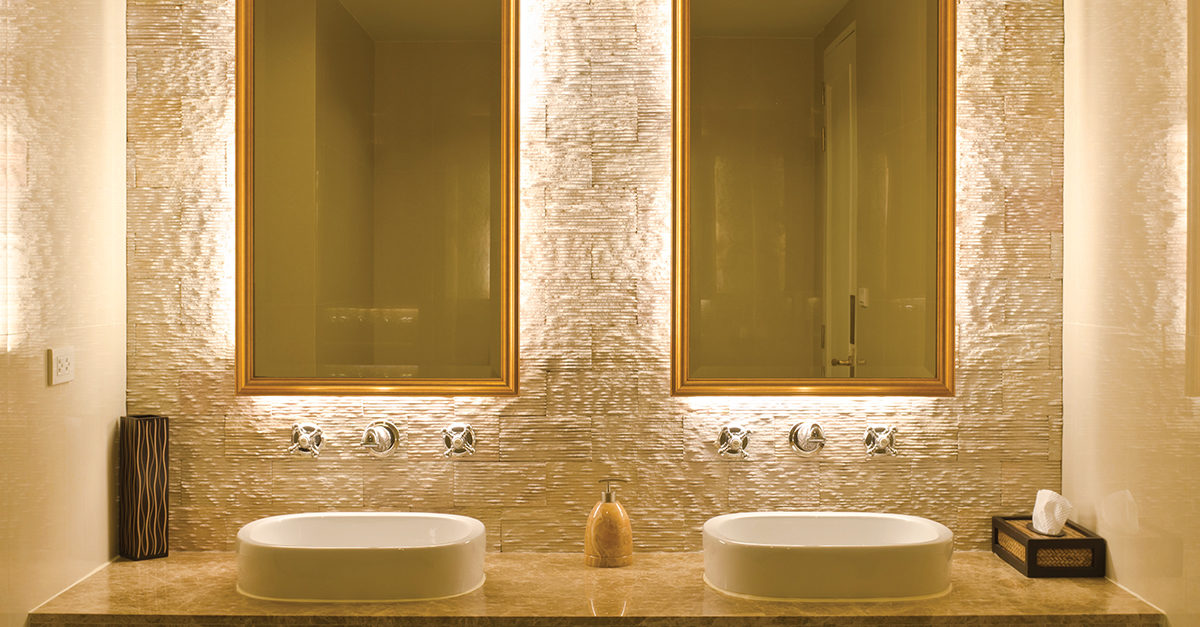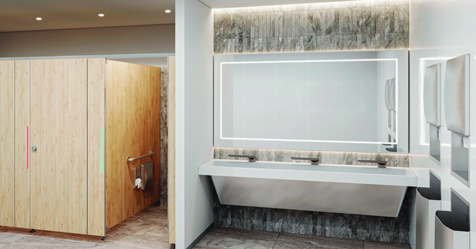I always cringe when a supervisor says, “Just clean the way you would at home,” since there are a host of differences to be taken into account, including tools, processes, and even chemicals.
Most commercial restrooms in an office building, factory, or retail setting will have much more traffic per day than a personal bathroom, which means the soil load and supply usage is far greater, and therefore requires a higher degree of cleaning.
There are many other differences between a commercial restroom versus a home bathroom. In a commercial setting, there are often different dispensers for soap, towels, hand dryers, and even toilet tissue dispensers. There are usually several types of toilets, sinks, and possibly urinals, which makes them different from the typical home bathroom. The home bathroom will usually have a tub/shower combination, terrycloth hand towels, a simple counter soap dispenser, and a regular flushing toilet without a urinal in sight.
However, aside from differences in design and amenities, there are also differences in how these two different types of facilities should be cleaned and maintained.
Timing Your Work
When one cleans a personal bathroom, that person usually has the luxury of taking his/her time and performing the tasks during any time of day or night. When one services commercial restrooms, it is usually after hours and there is pressure to perform the tasks as quickly and effectively as possible in an effort to control labor costs. Most workers will usually have a utility/restroom cart with a mop/bucket combination designed to process an area quickly and effectively without having to go back to the custodial closet for supplies.
Let’s say you are servicing a building with public restrooms on each of 10 floors with a total of 12 fixtures in each. You will need to organize your supplies, equipment, and processes to accommodate time constraints. One cleaning times standard allows for 2.5 minutes per fixture, which most time standards recognize as a toilet, sink, or urinal. This includes more than cleaning and disinfecting the unit; it also takes sweeping, mopping, pulling trash, spotting walls, dusting, and other periodic tasks into account.
In this example, since you have 12 fixtures in each restroom, the math would break down as follows:
- 12 fixtures x 2.5 minutes per fixture = 30 minutes on average to service the restroom properly
- 30 minutes x 20 restrooms = 10 hours on average per visit.
Once you are organized, you will find that your times will drop due to experience and differences in the restrooms. Some restrooms will consume the entire time, while low-usage ones will allow you to find time savings to reduce your overall labor hours.
Once you become familiar with your route, you will be able to service all the restrooms in one eight-hour shift. This savings assumes a daily quadrant cleaning schedule that allows you to hit select areas on a weekly basis.
It is important that you develop a schedule with select tasks to perform during each visit with other tasks performed less frequently. This workloading schedule will be determined by specifications, traffic, access, desired appearance level, and other factors.
Proper Cleaning Tools
Let’s look at the equipment, supplies, and tools you will need. The list is much more expansive than what you would use to clean a home restroom.
- A custodial restroom cart large enough to carry supplies;
- A mop bucket/wringer along with one or more mops. Mops can have traditional heads made of string or a variety of microfiber heads. The key is to identify the most effective mopping system for a particular set of restrooms. If your company provides a microfiber cleaning system, by all means use it;
- Lots of cleaning supplies, such as a broom, dust pan, putty scraper, razor blade tool, bowl swab, inspection mirror, lamb’s wool duster/sleeve, spray bottle(s) with appropriate chemicals (all purpose, disinfectant and glass cleaner/polish), and cotton cloths or microfiber wipes (color-coded is preferable);
- Consumable supplies, which may include hand soap, toilet tissue, paper towels, seat covers, sanitary napkin bags, and other items unique to some restrooms; and
- Personal protective equipment (PPE), which may include appropriate rubber gloves, face/eye protection, and slip-resistant shoes, although other items may be required.
Note that you may need separate training in how to handle bloodborne pathogens that can be common to public restrooms. This includes any bodily fluids, such as feces, urine, and blood.
Servicing Commercial Restrooms
Remember, the ultimate purpose of cleaning/servicing a restroom is to provide a clean, odor-free facility with adequate supplies, clean and safe floors, and an area that is welcoming to building occupants. Your job of cleaning and servicing these restrooms is very important, not only to your company, but also to the customer who wants to make a great first impression.
The following are suggested steps for servicing a restroom:
- Gather supplies on a cart or caddy and proceed to the first restroom.
- Place safety/wet-floor signs when directed.
- Always announce yourself before entering a restroom of the opposite sex.
- Pick up loose litter, sweep, or dust-mop the floor. Remove any floor mats/pads.
- Apply disinfectant product to toilets/urinals, sinks, faucets, and counter tops. Be sure the product meets the prescribed dwell/contact time (usually 5-10 minutes wet) before removing it.
- Inspect and refill all paper and soap dispensers, hygiene products, and odor control devices.
- Using a treated cloth, spray/wipe toilets and urinals, giving special attention to side panels and splash areas.
- Using a separate (different color) microfiber cloth, wipe down sinks, faucets, and counter tops.
- Clean mirrors with an all-purpose or glass cleaner, wiping with the grain.
- Wipe down all soap and paper dispensers.
- Starting in the back of the restroom, damp-mop your way out, using care not to splash the baseboards.
- Leave wet floor signs and proceed to the next restroom.
- Note that if the restrooms are small and close together, you may perform steps 2–5 in each to allow for sufficient dwell time.
You can adjust most of these steps to fit your own needs; however, make sure to always apply the disinfectant as early as possible so it will have sufficient dwell (contact) time to do its job. Simply employing a spray-and-wipe technique is not effective in true disinfection. Read the specific product label carefully so that you are truly disinfecting the key touch points. This one point can go far in reducing the spread of contagion.
There may also be some quadrant cleaning or irregular tasks involved. You may have to:
- Inspect and clean air vents on a weekly basis before sweeping or mopping floors.
- Pour mop solution or enzyme solution down floor drains on a weekly basis, or even more often based on how quickly the drain dries out.
- Wash mirrors from top to bottom.
- Perform any other necessary tasks as described in specifications.
The End Result
There are many steps that go into servicing a commercial restroom that do not apply to your home bathroom. However, the final result should be a clean, well-stocked restroom.
Keep note of how long it takes for each restroom and realize that some will take a little longer than others. Also, your speed will increase over time. Public restrooms come in all sizes and configurations, and the suggested time standards may not apply to your particular situation.




